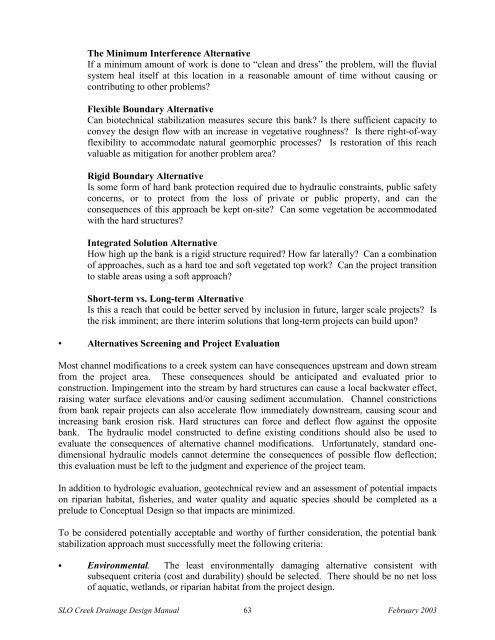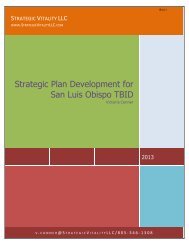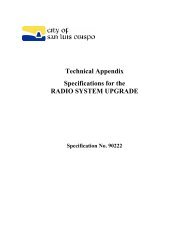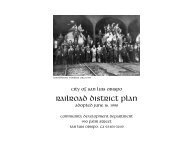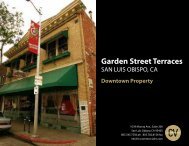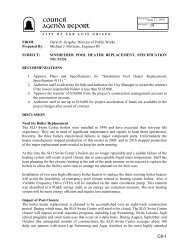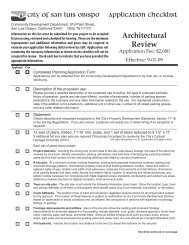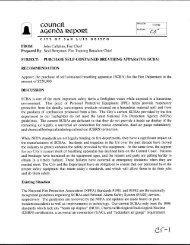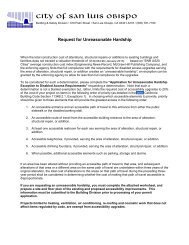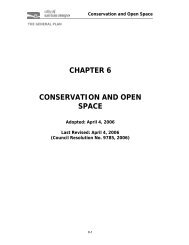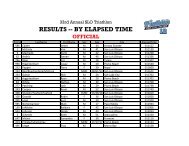Drainage Design Manual - the City of San Luis Obispo
Drainage Design Manual - the City of San Luis Obispo
Drainage Design Manual - the City of San Luis Obispo
You also want an ePaper? Increase the reach of your titles
YUMPU automatically turns print PDFs into web optimized ePapers that Google loves.
The Minimum Interference AlternativeIf a minimum amount <strong>of</strong> work is done to “clean and dress” <strong>the</strong> problem, will <strong>the</strong> fluvialsystem heal itself at this location in a reasonable amount <strong>of</strong> time without causing orcontributing to o<strong>the</strong>r problems?Flexible Boundary AlternativeCan biotechnical stabilization measures secure this bank? Is <strong>the</strong>re sufficient capacity toconvey <strong>the</strong> design flow with an increase in vegetative roughness? Is <strong>the</strong>re right-<strong>of</strong>-wayflexibility to accommodate natural geomorphic processes? Is restoration <strong>of</strong> this reachvaluable as mitigation for ano<strong>the</strong>r problem area?Rigid Boundary AlternativeIs some form <strong>of</strong> hard bank protection required due to hydraulic constraints, public safetyconcerns, or to protect from <strong>the</strong> loss <strong>of</strong> private or public property, and can <strong>the</strong>consequences <strong>of</strong> this approach be kept on-site? Can some vegetation be accommodatedwith <strong>the</strong> hard structures?Integrated Solution AlternativeHow high up <strong>the</strong> bank is a rigid structure required? How far laterally? Can a combination<strong>of</strong> approaches, such as a hard toe and s<strong>of</strong>t vegetated top work? Can <strong>the</strong> project transitionto stable areas using a s<strong>of</strong>t approach?Short-term vs. Long-term AlternativeIs this a reach that could be better served by inclusion in future, larger scale projects? Is<strong>the</strong> risk imminent; are <strong>the</strong>re interim solutions that long-term projects can build upon?• Alternatives Screening and Project EvaluationMost channel modifications to a creek system can have consequences upstream and down streamfrom <strong>the</strong> project area. These consequences should be anticipated and evaluated prior toconstruction. Impingement into <strong>the</strong> stream by hard structures can cause a local backwater effect,raising water surface elevations and/or causing sediment accumulation. Channel constrictionsfrom bank repair projects can also accelerate flow immediately downstream, causing scour andincreasing bank erosion risk. Hard structures can force and deflect flow against <strong>the</strong> oppositebank. The hydraulic model constructed to define existing conditions should also be used toevaluate <strong>the</strong> consequences <strong>of</strong> alternative channel modifications. Unfortunately, standard onedimensionalhydraulic models cannot determine <strong>the</strong> consequences <strong>of</strong> possible flow deflection;this evaluation must be left to <strong>the</strong> judgment and experience <strong>of</strong> <strong>the</strong> project team.In addition to hydrologic evaluation, geotechnical review and an assessment <strong>of</strong> potential impactson riparian habitat, fisheries, and water quality and aquatic species should be completed as aprelude to Conceptual <strong>Design</strong> so that impacts are minimized.To be considered potentially acceptable and worthy <strong>of</strong> fur<strong>the</strong>r consideration, <strong>the</strong> potential bankstabilization approach must successfully meet <strong>the</strong> following criteria: Environmental. The least environmentally damaging alternative consistent withsubsequent criteria (cost and durability) should be selected. There should be no net loss<strong>of</strong> aquatic, wetlands, or riparian habitat from <strong>the</strong> project design.SLO Creek <strong>Drainage</strong> <strong>Design</strong> <strong>Manual</strong> 63 February 2003


